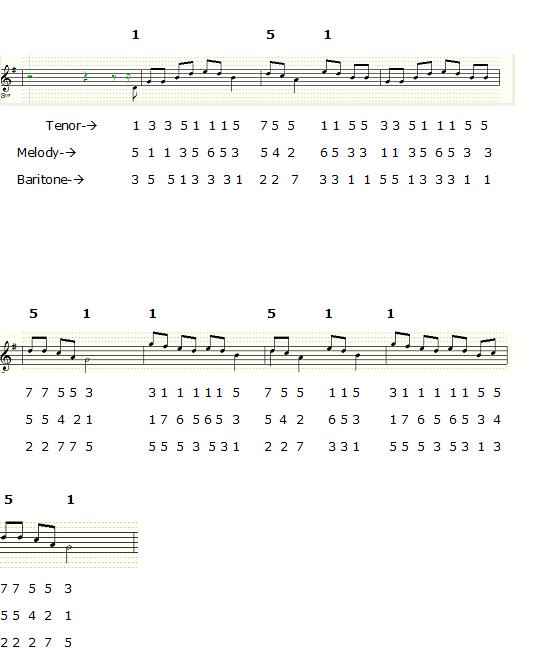Fiddlewidget for String Teachers
| Home | What's a Fiddlewidget? | Suppliers | Fiddlewidget University | Instruments |
Activity 6b-Finding Harmony Parts- Identifying the tenor and baritone parts
Time required: 20 minutes to one hour, depinding on time
devoted to practice
Materials:
1.The written score produced in Activity 6a, with the melody and chords shown in numbered scale
degrees.
2. The instrument that we are demonstrating, i.e. violin, viola, etc (a piano might be a good addition
here for playing all three parts at once, but is not absolutely necessary.)
What we'll be doing here is just adding two harmony parts to the melody line, by looking at
the underlying chord and picking scale degrees that most closely fit.
Activity: ask students to take the numbered score they produced in activity 6a, and add the closest notes above
and below the melody line that are in the underlying chord. The easiest way to do this is just to remember that
the 1 chord is the 1-3-5, the 5 chord is the 5-7-2 and the 4 chord, if applicable, is 4-6-1. (I don't have that
chord in Buffalo Gals.)
This should allow them to produce output that looks something like this:
 Another activity you might insert here is letting the class write in the tenor and baritone parts on the staff
notation, just to re-affirm that they understand how to relate the numbers with musical notation. I donít always
do that because bluegrassers are trying to get away from paper as much as possible, but there is really no good
reason not to do this. A little musical literacy won't hurt anybody.
Now for the practice part of the activity, try playing or singing the parts together.
Just do two at a time at first; the lead with the tenor and then the lead with the baritone.
This is where you notice that there are places where the notes get a little cramped and don't sound all that
good. We will look into cleaning up these spots in the next activity, but before we leave this one, I make sure
to leave the students with this thought:
The rules of harmony and chord construction go a long way toward giving us the harmony we want,
but you still have to try things out to be sure, unless you have a really great natural ear for that kind of
thing. The rules are not perfect, but they do give us a good place to start.
Another activity you might insert here is letting the class write in the tenor and baritone parts on the staff
notation, just to re-affirm that they understand how to relate the numbers with musical notation. I donít always
do that because bluegrassers are trying to get away from paper as much as possible, but there is really no good
reason not to do this. A little musical literacy won't hurt anybody.
Now for the practice part of the activity, try playing or singing the parts together.
Just do two at a time at first; the lead with the tenor and then the lead with the baritone.
This is where you notice that there are places where the notes get a little cramped and don't sound all that
good. We will look into cleaning up these spots in the next activity, but before we leave this one, I make sure
to leave the students with this thought:
The rules of harmony and chord construction go a long way toward giving us the harmony we want,
but you still have to try things out to be sure, unless you have a really great natural ear for that kind of
thing. The rules are not perfect, but they do give us a good place to start.
Available from nationally known music suppliers, or call Bruce Haney at (423) 349-6715
or
email at bfhaney@chartertn.net.